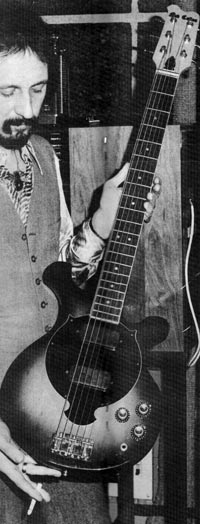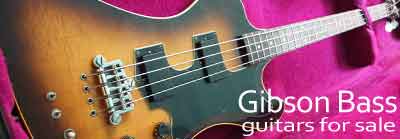This very interesting bass was sold by Heritage auctions in October 2017. It was listed as a potential prototype six string RD bass, though with no 'story' from an owner, no provenance, and very little description of the bass. Its authenticity is certainly open to question, however it has some unique features that certainly warrant discussion and therefore inclusion on FlyGuitars.com.
If you know anything about this bass, or just have an opinion, feel free to comment.
Let's take a look...


Body
The body is constructed of two pieces, presumably maple. The reverse control cavity has been routed rather similarly to the RD Standard. There is no evidence that this body was previously fitted with the Gibson three point bridge. The neck is not set into the body, but bolted on, attached with four bolts through typical Gibson branded neckplate.
What's wrong? RD basses have a set neck? Also the string through ferules are poorly aligned
What's right? It's known some pre-production examples of the RD (maybe as few as one) had bolt on necks - you can see an example of Bob Moog working on one here Bob Moog at work on the RD bass.
Neck
The neck is the most interesting part of this guitar. It is one-piece maple with the headstock attached via a scarf joint; rather similar to the Grabber or G3 necks. The serial number GS7 is 'stamped or scratched' onto the back of the headstock.
What's wrong? Tuning keys have no ferules. Is this just a regular neck redrilled?
What's right? Headstock logo seems too good to be a fake. Serial number seems to bad to be a fake. Around this time, guitars with unusual headstock designs were typically constructed from a one-piece neck with a scarf joint. The Grabber, G-3 Marauder and S-1 being prime examples. This was only the case for a few years in the mid-late 1970s; if Gibson were to create the elongated headstock required for a six string bass, this would quite likely be the construction method. No other RD bass has surfaced with one-piece scarfed neck and yes, comparing this headstock with a production RD shows it is indeed longer.

Electronics
Nothing is known about the electronics, other than that the pots date to late 1976. The pickups seem to be the same as used in the G3 - although they may be wound very differently? The controls (three way switch, varitone and two pots) have no direct correlation to any other Gibson bass, though they are all parts used widely by Gibson, and could easily represent something Bill Lawrence was working on (a combination between the S1 guitar and G3 bass?), although he left Gibson to start Lawrence Sound Research around this time (maybe late 1975) he remained as a consultant for some time. Lawrence, whilst still with Norlin, filed a patent in 1975 for an Electronic pickup system for stringed musical instrument which had the same two-way and four way controls, plus describes an optional sliding center pickup, and optional switch to trigger stereo output. Perhaps even, a previous scratchplate allowed the center pickup to move?

Entwistle had tried the G3 on a visit to the Kalamazoo plant in early 1976, and complained about the guitar's shape.
What's wrong? G3 pickups are easy to find, and an associated loom would quite likely be dated 1976.
What's right? The G3 was Gibson's brand new bass around the time this was constructed, and Bill Lawrence had taken the electronics further still. Prior to the new RD pickups, perhaps these would be the most logical pickups to try? They are certainly tonally closer to the Alembic basses Entwistle was so inspired by, than the Thunderbirds he had just stopped using.
Hardware
The components fitted to this bass are quirky to say the least. The scratchplate is scrappy, but, according to Heritage 'likely original' - presumably there are no extra screw holes. Likewise the back cavity cover is a poor fit. The bridge has saddles and screws similar to ones in use by Gibson, but the base unit is completely unique. Gibson had no six string bass, and if they were to test the concept would have to come up with a bridge in their workshop.
What's wrong? Everything looks too scrappy to be a production instrument. i.e. it's home-made
What's right? Everything looks too scrappy to be a production instrument. i.e. it's a prototype

A six string bass? Really?
Another problem with this bass is that, in general, there was no market for six string basses at this point. Gibson had not produced a six string bass since the EB6 in the early 1960s, and have not made one since. When they did produce them they sold poorly. So were they really looking at the possibility? As noted above they did not have the required hardware (e.g. a six string bridge/tailpiece); with poor projected sales could they justify the development expense? The answer is probably not... and this bass was never built. However, the RD series was developed (at least initially) in conjunction with Who bassplayer John Entwistle (see RD bass timeline). The Who were massive at this time, and people were offering endorsements to Mr. Entwistle left, right and center. He could be choosy. Alembic had recently made him custom eight string Explorer-style basses, though with strings in pairs, whilst British guitar maker Peter Cook, who had been customising Entwistle's basses for many years, had built him a six string 'Ned Callan' bass - pictured here, exactly at the right time, from an article in May 1977. Fashionable or not, Entwistle certainly had an interest in multi-string basses in the mid seventies, and could easily have asked Gibson to explore the idea.
General theories
It is impossible to say anything with any certainty about this bass - especially without examining it, and without knowing it's story over the last 40 years. Perhaps some of this will come to light in the future. It is my view that if a six string RD bass was worked upon in late 1976, it may well have looked like this. If it were an early stage experiment, not designed for demonstrating to the public, less attention would have gone into cosmetic appearance.
Gibson Artist Chuck Burge joined the company in early 1976. He remembers working on early RD examples, "..marketing were screwing with everything halfway between getting it done and the show ..I think the prototypes are all but completely done, they said don't make them bolt-on... make them glued in".
To be fair Chuck was a little vague in his memories of the earliest RDs, but when asked what happened to Gibson prototypes in general.. "They got stuck up the tubes. We had racks upstairs at Gibson, in a storage area, that were just like wooden shelving with case boxes.. guitar case boxes... solid. Which we called the tubes. And when we got done with it, we stuck it out of the way in one of those tubes. Last time I seen any of them, that's where they were."
"I think probably when the closed the plant, and it became Heritage, some of that stuff was still up in storage, or it had been cut in half and tossed in a dumpster... or somebody grabbed it. Could be some of that stuff somebody said i'll hang on to that."
So did a six string RD prototype get put in the "tubes"? It is possible that only some of this bass was 'original' with parts added or changed over the following decades? The bass could easily have been broken down into parts. So from this point of view, the best candidate for originality would be the neck, followed (some way behind) by the body. Recreating the body would not be difficult. Recreating the neck, and taking the unusual step of scarfing the headstock is far less likely.
The originality of the scratchplate and electronics, as easily replaceable as they are, is less certain. This bass would never have been sold in it's current state, however somebody could easily have assembled the bass around the neck, with a few G3 and Ripper parts.
Opinions are divided about this bass - if you can add anything to this story, please comment
Gibson RD bass guitars for sale
1978 Gibson RD Artist "NATURAL BLONDE" Electric (MOOG) Bass + OHSC
San Jose, California, 951**, UNITED STATES OF AMERICA
$4000
" NATURAL BLONDE" FINISH
GIBSON NORLIN-ERA
Original MOOG ELECTRONICS
Made in USA (Kalamazoo Plant, MI)
Production # 102 (April 17th release)
Adult owned only. Children-free, Pet-free household. Kept inside case when not used
Up for sale is a BEAUTIFUL LATE-70's Gibson Bass Guitar (RD ARTIST)
EXCELLENT overall vintage condition. Standard surface scratches, light dings, marks on front / back body / ... more
Gibson RD Artist Bass w / Bag! -LL
Mesquite, Texas, 751**, UNITED STATES OF AMERICA
$3000
Item: Gibson RD Artist Bass w / Bag!
Description: You are purchasing a Gibson RD Artist Bass w / Bag!Neck had a break but has been repaired. See PhotoIT has some wear and tear from normal usage Beautiful flamed wood finish Plays and sounds Please ask any questions before buying if you have any Shipping: $100 00 shipping to the Lower 48 States! We ship overseas. Overseas shipping prices will vary. Overseas buyers pay their own import taxes Payment: We accept Paypal for your ... more
1976 RD Standard Gibson Jazz Bass Guitar
Mission Hills, California, 913**, UNITED STATES OF AMERICA
$3000
PICK UP ONLY Mission Hills, CA (LA ... more




